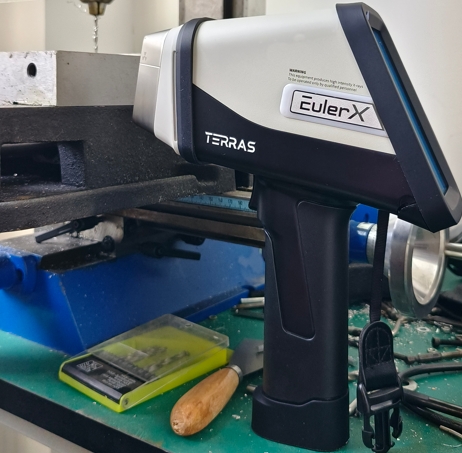
Alloy
A high-tech enterprise focusing on the development and application of X-ray technology products, committed to becoming a leading supplier of X-ray industrial testing solutions.
The Evolution of Portable Ion Mobility Spectrometers: A Technological Breakthrough
In the world of analytical chemistry and detection technology, portable ion mobility spectrometers (IMS) represent a significant leap forward. These devices, which were once confined to laboratories due to their size and complexity, have evolved into compact, versatile tools that are revolutionizing fields from security to environmental monitoring.

Early Days: From Lab Benches to Field Applications
Ion mobility spectrometry itself dates back several decades, primarily used in research settings to separate and identify ionized molecules based on their mobility in a carrier gas. Early IMS devices were bulky and required a controlled environment, limiting their practicality outside of well-equipped labs.
Miniaturization and Mobility
The turning point came with advancements in miniaturization and engineering. Researchers and engineers began developing portable IMS devices that retained the analytical power of their larger counterparts while becoming small enough to carry into the field. These advancements enabled real-time detection in various environments, including airports, border crossings, and industrial sites.
Applications Across Industries
The versatility of portable IMS devices has opened up a range of applications across different industries:
Security and Defense: Portable IMS devices are integral to detecting explosives, narcotics, and chemical warfare agents. Their rapid response time and sensitivity make them invaluable tools for security personnel and military units worldwide.
Environmental Monitoring: From monitoring air quality to detecting pollutants in water sources, portable IMS devices play a crucial role in environmental protection. Their ability to detect trace amounts of chemicals helps identify sources of contamination swiftly.
Healthcare and Pharmaceuticals: IMS technology aids in pharmaceutical quality control by detecting impurities and ensuring product integrity. In healthcare, these devices are used for breath analysis and disease diagnostics, showcasing their potential in non-invasive medical testing.
Technological Breakthroughs Driving Innovation
Several key technological breakthroughs have propelled the evolution of portable IMS devices:
Improved Sensitivity and Selectivity: Advances in ionization techniques and detector technologies have enhanced the sensitivity and selectivity of IMS devices, allowing for detection at lower concentrations and reducing false positives.
Battery Technology: Efficient power management and the development of long-lasting batteries have extended the operational capabilities of portable IMS devices, enabling extended field deployments without frequent recharging.
Data Integration and Connectivity: Integration with mobile devices and cloud computing has streamlined data analysis and reporting. Real-time data transmission allows for immediate decision-making, enhancing operational efficiency in dynamic environments.
Future Prospects: Beyond Current Limitations
Looking ahead, the future of portable IMS technology holds promise for further miniaturization and increased functionality. Advancements in nanotechnology and artificial intelligence may lead to even smaller, more sensitive devices capable of autonomous operation and adaptive response.

Advantages of XRF
Non-destructive analysis: XRF technology can analyze without destroying the sample, which is suitable for analyzing precious or irreplaceable samples, such as cultural relics, artworks, etc.
Multi-element analysis: XRF can analyze multiple elements at the same time, covering a range from light elements (such as magnesium and sodium) to heavy elements (such as lead and thallium), and is suitable for a wide range of sample types.
Surface analysis capabilities: XRF is mainly suitable for analyzing the elemental composition of the surface or near the surface, and is particularly useful for materials such as metals, alloys, and coatings.
Instant results: XRF provides real-time qualitative and quantitative results, suitable for occasions that require rapid decision-making or real-time monitoring.
Wide application: It is widely used in mineral exploration, metal analysis, environmental monitoring, pharmaceutical quality control and other fields, especially in scenarios that require rapid analysis and non-destructiveness.
The EulerX 900 series has proved to be an excellent choice for metal analysis in a wide fields, providing fast, accurate results directly to the user. Thanks to its cutting-edge electronics and sophisticated mathematical algorithms, the EulerX 900 series ensures superior measurement quality within seconds. This makes it an ideal tool for inspecting and analyzing incoming materials, finished products, and in-process production parts in a non-destructive manner. Its simplicity of operation allows users to quickly view alloy grade and chemical composition on the touch screen display, achieving laboratory-quality analysis with minimal training and virtually no need for sample preparation, regardless of the sample is shape or size.
Conclusion
The evolution of portable ion mobility spectrometers represents a transformative shift in detection technology. From their origins in research labs to their current deployment in diverse real-world applications, these devices continue to redefine the boundaries of what is possible in analytical chemistry and detection sciences. As technology continues to advance, portable IMS devices are poised to play an even more integral role in ensuring safety, security, and environmental stewardship on a global scale.
Join Us
Subscribe to our email list for updates & promotions.



